Ghosts in the Shell
Shirow Masamune's Ghost in the Shell franchise consists of manga, animted films, computer games, books, and an animated TV series. Although they all contain the same characters, in the same universe, dealing with the same kinds of situations, each type of publication is significantly different from the others.
These differences run to the point where some people will love one incarnation but hate another.
Rather than extole the virtues of the franchise, this article will serve to highlight the many differences between the different incarnations.
Warning: This article is rather long. Not advisable reading material for narcoleptics.
In particular, this article will cover the original Ghost in the Shell (hereby referred to as 'GitS') manga [1], the first animated film (Imaginatively titled GitS [2]), the second animated film (GitS 2: Innocence [3]), and the first season of the animated TV series (GitS: Stand Alone Complex [4]). Fans of the franchise will no doubt be aware that there are sequels to the original manga available, as well as a second season of the TV series, and the aforementioned books and computer games. A third film (Based around the TV series) also made its way into Japanese cinemas last month. This article will not be convering any those works, as I haven't seen them.
A brief introduction
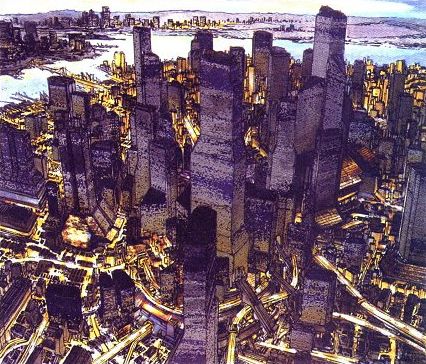 |
Those who haven't seen or heard of it before may be wondering what GitS is. GitS is set in the cyberpunk dystopia of 2030's Japan. Advances in the field of cybertechnology allow for part or all of the human body to be replaced with man-made alternatives, resulting in improved strength, agility, and stamina. With the addition of cyber brain implants, person's soul - their ghost is able to travel freely across the internet - surfing the web has been replaced with 'diving the net', and a well-trained brain can be used to do anything from drive a car hands-free, record and replay experiences with photographic quality, and even forcibly take control of someone else's body. Advances in artificial intelligence also mean near-human androids are common in the workplace, and autonomous tanks march side-by-side into battle with cyborg human soldiers. The very term 'Ghost in the Shell' refers to the main subject of the manga and first film - the unexpected appearance of a soul (ghost) inside an equally unexpected cyborg body (the shell), as orchestrated by the Puppet Master supervillain.
Also it's worth pointing out that "Stand Alone Complex" probably doesn't mean what you think it does. Instead of referring to the setting of the series, it refers to the nature of the episodes. Each episode is either stand alone (i.e. it contributes little to the main story arc) or complex (i.e. it is an integral part of the main story arc).
Video comparison
Although the manga obviously doesn't contain any video content, I can at least describe what it looks like. The general page layout is the same as you'd find in any comic book - the action is layed out in boxes on the page, which if you're new to comic books means it may take you a few minutes to work out the correct flow between boxes. In terms of style, you can expect to see plenty of speed lines, and a healthy dose of traditional manga facial expressions.
Around 30 or so of the 368 pages are in full colour, while the rest are in black and white. I can only assume that this is as the original manga was distributed. Almost all of the frames contain an impressive amount of detail, whether in the characters or the backgrounds. The colour pages have a distinct patchy, watercolour look, which is in direct contrast to the style of the animated works.
Compared to the animated titles, working out what's going on during some of the action or cyberspace sequences can sometimes be a bit tricky. However this only goes with the territory (of trying to produce a short set of images that faithfully depict the events that occur over the course of time), so can hardly be blamed on the author.
One thing you may notice when viewing the different titles is that the main character - Major Motoko Kusanagi - is depicted differently in each incarnation. In the colour pages of the manga, she has red eyes, and either brown or iridescent blue hair. In the first film though, she has near-black hair and cold, light-blue eyes. In the series, she has violet hair and red/brown eyes.
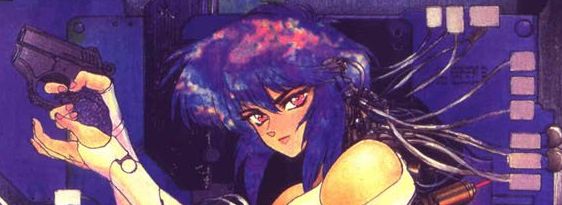 |
 |
Considering that she is a full-body cyborg you could argue that her appearance is a minor point, as she can opt to have whatever hair or eye colour she chooses. However I still find it interesting that they've decided to depict her differently in each title. Part of these differences are down to intentional decisions made by the production team - for example the making-of documentary on the GitS DVD reveals that the differences between her body in the film and the manga were made to highlight the maturity of her character.
A wider issue though is that of the differences in overall visual style between the works. The first film was famous for successfully melding hand-drawn animation with CGI. Compared to the manga, there is of course a striking difference between the two works. Some scenes feature entirely hand-drawn artwork, while others mix hand-drawn characters with CGI backgrounds. Others, such as those taking place inside cyberspace, are entirely CGI. Every frame in the film has been processed by computers, whether to add glows to lights and skin, or to perform lens effects such as fisheye or depth blur. The hand-drawn characters are sometimes shown using a three-colour shading system, giving them more depth than the two colour system used by most other animation. The combination of all these factors is that the film has a very distinctive visual style, helping it to stand out from the crowd, and it also helps to set the tone of the film.
This brings us nicely onto the second film. This uses a lot more CGI than the first, and unfortunately for me it just doesn't fit. Almost all the backgrounds are CGI, which has allowed them to easily perform much more complex camera movements. However it also means the hand-drawn characters stick out like sore thumbs. There's simply too much of a contrast between the two styles, and in the end you're left wondering whether the film you're watching is meant to be an animation or a CGI movie.
...Which brings us nicely onto the series. Produced on a tighter budget and in a shorter timespan, very little of the series consists of full CGI images. The non-CGI backgrounds appear to be fully hand-drawn, while the human characters appear to be have been produced entirely on computer. I haven't done any direct research into this (chances are one of the interviews on the DVDs will reveal the truth), but I'm guessing they were drawn with the help of a graphics tablet. One thing is for certain though - all the scenes are composited using computers, like those of the films. To me the shading of the characters is much less pronounced, making them appear flatter. Some of the mechanical objects - such as tanks and cars - are cel-shaded computer models. Combine this with the use of computers to perform depth blur, 3D camera movement, and other effects, and you'll get a very flat, plasticy visual experience when compared to the first film.
|
|||
|
|
||
Despite the plasticy appearance, the characters appear to have more emotion. I think this is down to the differences in the eyes - for example in the first film the Major has very cold light-blue eyes, while in the series she has dark red/brown. In fact, I'm fairly certain it's been mused somewhere that the only creature to show any real emotion in the second film was Batou's dog.
Another point of contention for me are the intro credits to the series. As seen above, these are entirely CGI, and, as is the case with most anime series, are rather long - weighing in at a minute and a half. To me it seems rather misleading to have a CGI introduction to a hand-drawn series, and it makes it all look rather out of place. If you've read my previous article you'll know that I'm not particularly impressed with CGI, and the CGI in the intro sequence isn't exactly great. In fact, it reminds me of the mediocre CGI FMV sequences you'd see in a computer game. Add all these factors together and it makes the series look rather cheap, compared to the effort put into the visual style of the first film. This isn't to say that the visuals in the series aren't any good, but they are certainly very different from anything else I've seen recently.
In terms of video, we can also talk about the setting. The true setting for the franchise is in Japan, but for the first film the decision was made to set the action in Hong Kong instead. This helps to give the film a darker atmosphere, as the characters navigate the grime of the crowded city. The series on the other hand has much brighter locales, and a good deal of the action takes place during the day (Compared to the films where it is almost exclusively at night or in shadows). Whether night or day however, the background images in both films and the series all contain an impressive amount of detail.
 |
Audio comparison
Unless I'm mistaken, my copy of the manga didn't come with an audio track. However it does contain numerous audio hints, of the "Vhip", "Spak", "Whudd", "Splk", "Pop", "Brmbbrmbbrmb", "Kboomf" variety. I'm not entirely sure who did the translation from the original Japanese, but if you take the time to read the audio hints then you'll find that they do infact match the sounds you'd expect to hear in the situation depicted. The English voice talent is excellent, and the characters sound exactly as you'd imagine them to sound if they were real.
The audio for the animated titles is as good, if not better, than that of the manga. The sounds are convincing, and as far as I can tell, the Japanese voice talent appears to be good. In particular one advantage over the manga is that it's blatently obvious whether someone is talking directly, talking through cyberspace, or the voice is coming from a computer. In the manga these are all depicted by different styles of speech bubble, which means on first reading it will take a while for the reader to work out the significance of the different styles.
The good news for Japanese fans is that the same voice actors are used in the films and in the series [5], but unfortunately the cast of the English dubs has changed a bit over time (In particular I think the main (only?) differences are between the first film and the series/second film). I would comment on the quality of the English voice acting, but as stated in the footnotes I haven't really listened to any of it. The advantage for me of listening to only the Japanese is that if the Japanese acting is bad, I'm less likely to notice it than if the English acting was bad - thus my enjoyment of the series won't be spoilt.
One interesting point about the voices though is how they treat cyber communication. In the first film, a spatialiser was used extensively to give the cyber communication a very distinctive, hollow sound. This effect seems to have been toned down a bit in the series, for unknown reasons.
Music plays a very important part in setting the atmosphere of the films. For example the music for the first film had lyrics composed in the ancient Japanese language of Umaka [6]. This gives it a very mysterious and foreign feeling, serving to attenuate the differences between our world and the world of GitS. It's also as if the music is being used to attenuate the Major's own feelings of distance and alienation from the world around her.
Compared to the films, the music used in the series is almost completely different. Gone are the haunting sounds of Umaka, and in its place you will hear an electronica/metal soundtrack [7]. The electronic sections (along with some orchestral bits) are used to set up much of the tone of the scenes, while the metal/rock is reserved for some of the action sequences. This combination alleviates much of the dystopian vibe that the first film had, giving the series a much brighter outlook and adrenaline-fueled action sequences.
If you're fluent in Russian, English, and Latin, you may stand a chance at understanding the music used in the intro credits to the series - Inner Universe by Origa. The repeated phrase in the song, "aeria gloris", ("heavenly glory" in English) has even spawned its own website, which gives a useful explanation of the music. Useful because it means I don't have to try and explain its significance myself [8].
Story comparison
There is a great deal of overlap in the story of the different titles. This is because all of the animated titles contain retellings of certain sections of the manga. All are technically based in the same universe, but the only titles which directly relate to each other are those of the same media type. The manga sequel is a sequel to the first manga; the film sequel is a sequel to the first film; the series second season is the sequel to the first; etcetera.
So without trying to give away too many spoilers, I'll attempt to highlight which title covers what. And in order to do this, I'll start from the animated titles and work back.
The first film - weighing in at a mere 83 minutes - only serves to cover the main plotline of the 368-page manga - that of the Puppet Master and the "Ghost in the Shell" that I talked about in the introduction. All of the subplots have been omitted, and the execution of the main plot has been changed significantly. Gone are the pre-Section 9 days, and a battle with a walking tank that occurs midway through the manga, instead is reworked as the traditional final battle at the end of the film. Despite this heavy reworking, the story loses none of its impact. In fact it could be argued that the film has more impact than the manga, due to the culmination of all its component parts. Many of the philosophical discussions in the manga have been omitted or simplified, which again makes it easier to understand the core concept and give the film more impact for the average viewer. Depsite its relatively short runtime the film was deliberately made slow paced, as the pacing is used to give it much of its atmosphere. This means that ultimately the film is providing a mere glimpse into the world of GitS, and will leave the viewer (or me at least) wanting more, with a head full of questions and possibilites.
The second film, although set after the first film, appears to take the inspiration for its story from a short subplot contained in the first manga (A subplot that occurs before the main plot has played out, in fact). This results in a bit of a criss-cross of timelines if you were to try to directly relate the two. This also means that a lot of the story is an original creation. Unfortunately for me, the story fails to create the same level of impact as that of the first film. According to the director, the intention was for the film to be more an exploration of the GitS universe, of philosophy, and an expirement in animation techniques, rather than a direct story-based successor to the original film. This means that a person's dislike of the film for its weak story is justified. Despite Oshii's reasonings, however, it still doesn't change the fact that some of the plot is downright confusing. For example I was able to easily understand the goings-on inside the doll house manor, but have no idea how they got from outside the Locus Solus building to outside the manor in the first place. I don't even know of the manor was real or exists only as a virtual construct.
The story of the series continues to mix the manga plotlines with new content. Several of the stand alone episodes are reworked retellings of manga subplots, but the main story arc neglects the Puppet Master and instead introduces a new super-villain, The Laughing Man. In the manga there was a story concerning the revolt of Section 9's walking tanks (called Fuchikomas in the manga, and Tachikoma's in the series, and omitted altogether in the films). In the series, greater importance is placed on this story, presumably due to the absense of the themes introduced to the film and manga by the presence of the Puppet Master [9].
Onto some specifics, then. In particular, something that will surely grab the attention of our readers - big naked titties.
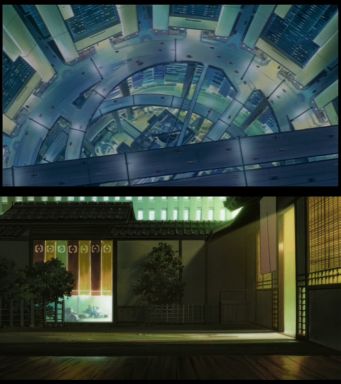 |
To the right you will find two images. They both show the Major doing the same thing, that is, being invisible. This is possible thanks to the optical camouflage technology that Section 9 has access to. However there is one key difference between the two images: In the top image, she is practically naked. In the second image, she is fully clothed. The fact is that during the film, the only way she appears to be able to use the camouflage technology is to remove her clothes and put on a thin, translucent bodysuit. None of the other characters do this. In the series and manga, she's able to use camouflage while fully clothed. So why exactly did the makers of the film feel the need to place this constraint on her camouflage ability? Maybe she has some weird fetish of being naked while apprehending her target? Or maybe the bodysuit makes less noise than her combat gear, and provides more freedom of movement? This is, of course, just speculation over what appears to be a case of fanservice.
Apart from providing titilation for the viewers, (assuming you get horny at the sight of genitalia-less cyborgs), it appears there may be a reason for her nudity. It's used as a plot device to show Batou's caring, loving relationship with the Major. Whenever the Major gets naked, Batou is there to place a jacket over her shoulders, to hide her (artificial) shame. Even when she manifests herself in a sex doll in the second film, Batou still feels the need to cover her body [10]. However, even this explanation doesn't fit entirely, as no hint of a relationship of this kind between the Major and Batou is made in the original manga.
In fact, the manga goes so far as to state the opposite. Not only does the Major have an active sex life with her boyfriend (who isn't mentioned at all in the series or films), but she also takes part in lesbian cybersex orgies, which adorn 3 of the full-colour pages in the manga. When Batou inadvertantly interrupts the Major during an orgy, he's rewarded by the Major hacking his brain and causing him to punch himself in the face. As can be expected, there's some discussion about the relevance of this cybersex, and the oh-so-important question of the Major's sexuality, available at the wikipedia. Despite my bemusal over the Major's requirement to be naked to be invisible in the first film, I'm trying to stick to reporting the facts in this article, so will leave the hypothesising and fanwanking (Whether literally or metaphorically) to the experts.
Back to the facts, then. One thing that I've noticed is that, despite being approximately the same size and weight as a car, the Tachikoma are able to dive from helicopters and land on glass walls without breaking the glass. Either they have incredibly strong glass in the future, or the physics of the situations have been simplified. This is somewhat disappointing to me, as GitS represents a very possible future [11].
On the subject of reality, one thing that the manga does have that the other incarnations don't [13], are the occasional notes of text next to frames. These give more depth to the universe, by explaining what things are or what they're used for. At the back of the book there are also several pages of notes, explaining some of the more complex goings-on, the science behind some of the technology, or philosophical musings about life and death. Unfortunately you're only likely to find out about these once you've finished reading the book, as no forward references are made to them. This means that once you do find them, you have to constantly flip pages back to see what they're in reference to.
Another point worth raising is that of Batou's relationship with the Tachikoma. In the manga and series he has a favourite tachikoma, which he gives natural oil instead of synthetic (Which leads to some unwanted side-effects later on, helping to provide more story for the world). But there are no Tachikoma in the films, so in the second film Batou (who is the main character this time round) is given a pet dog. For all intents and purposes the dog is a surrogate tachikoma - he feeds it organic dog food instead of processed. His special treatment of his dog even ends up causing similar problems as with the tachikoma [14].
Discummary [15]
Each title in the GitS franchise has its own specific style. The manga contains a good amount of comedy, backed up by a complex storyline. The first film is very dark, focusing on only a few of the characters in Section 9. Pacing and music is used extensively to set the atmosphere, to the point where entire scenes are dedicated just to setting the atmosphere and provide no story content whatsoever. The second film retains much of this, but to me, the lack of a decent story makes it feel very hollow. The series on the other hand has a completely different feel - if the first film relies on atmosphere and story, then the series relies on story alone. The sunny settings the characters often find themselves in is in direct contrast to the dark settings of the films, and the difference in musical style means it is a more of a jolly action-packed romp than a dark dystopian tale. This isn't to say that the series can't be dark - some of the episodes are very dark - but for the mostpart is has a brighter outlook than the films, and contains some of the comedy elements from the manga (For example the Major's enjoyment of hacking people's brains in order to make them punch themselves). The first few episodes will feel weak compared to the films, but once you're into the main story you should find yourself enjoying it for what it is - essentially an anime version of the manga.
For an example of the comedy in the series, you only have to look at Tachikomatic Days. This is a series of sort animations (about a minute each) tacked onto the end of the episodes. As the name suggests, they concern the activities of the tachikomas, either discussing events or playing with each other. They have a silly, slapstick feel, and remind me a bit of the short extra-cartoony joke segments that sometimes appear in the manga. Ultimately however I'd be better off without them, as between the Tachikomatic Days, the intro credits, and the outro credits, each 25-minute-ish episode is reduced to a mere 21-ish minutes of real content. Also it means I have to scan past the credits and then stop for the Tachikomatic Days segment, rather than skip straight onto the next episode.
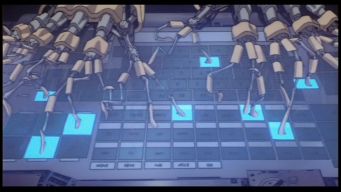 |
Another thing I've found interesting while watching are the typists' hands. These are special cyborg hands, with two operating modes - as normal human hands, or they can split the fingers up into 15-ish thin, mechanical fingers, greatly increasing the user's typing ability (Assuming they can think as fast as they can type). That's all well and good, but unless they're planning on entering data into old mainframes from the 60's, surely it would be a lot quicker, easier, and quieter to plug yourself into a USB socket?
Summary
As with any story that's been told through different, independent, mediums, there are many differences between the different incarnations of GitS. These differences include the visuals, audio, style, setting, and story. Some of the differences make sense, some of them don't. Some improve the end product, and some (in my opinion) don't. There are many more differences between the works than I've got time to discuss here, or that you've got patience to hear me talk about. Ultimately it's down to the viewer to decide which telling of a story they like the best [16].
[1] Obviously I'm not using the original manga, since I can't read Japanese. Instead I'm using Dark Horse's recently released new edition of the manga, which is "now restored in this new edition to its original collected format - and more adult treatment - as publish in Japan."
region 2 DVD, watched with the Japanese soundtrack and English subtitles.
[3] Obviously the film was titled "Ghost in the Shell 2: Innocence". Reference material was the 2-disc region 2 DVD, watched with the Japanese soundtrack and English subtitles.
[4] Obviously the series was called "Ghost in the Shell: Stand Alone Complex". Reference material was the region 2 boxset of season 1, watched with (You guessed it) the Japanese soundtrack and English subtitles.
[5] I haven't checked the names of every voice actor, but the voices sounded the same to me, so that's good enough. I'm sure someone will correct me if I'm wrong.
[6] I can't find a definite spelling for this. Expect it to be wrong.
[7] You can tell I'm good at describing music, can't you?
[8] See [7].
[9] You'll understand if you've seen it. I hope. If you don't understand, and don't mind a potential spoiler, read on!
The Puppet Master, also known as project 2501, was a computer program that became aware of its own existence, and thus became sentient. Its creators saw this as a bug, and tried to regain control of the Puppet Master. The Puppet Master evades them, and later confronts Major Kusanagi with a proposal - to meld their consciousness and become one entity. This gives the Puppet Master the ability to father children, and the Major the ability to leave her body entirely and live in freedom in the 'net. The story is, of course, dealing with what happens when one of mans creations inadvertently becomes a sentient life-form. This is essentially the same thing that happens in the series when the Tachikomas break their programming and become individuals.
[10] Or maybe that's just so he doesn't shoot her by mistake, considering that he's in a factory full of murderous sex dolls.
[11] Not only in terms of a dystopian society, but also in terms of the technology behind it. Although we don't yet have the ability to create a machine as complex as the human brain, the fact that the brain itself exists means that we should be able to reverse engineer it and create our own version - whether out of living tissue or cold steel. The fact that life exists also suggests that there is the possibility that we can create new types of life - whether accidentally or on purpose (Assuming we ever find a way to decide what life is, of course). Obviously this might not all happen in the next 30 years, but while we're still unravelling the mystery of the universe it would be pointless to rule it out entirely [12].
[12] Except for time travel. God, that's so stupid.
[13] Unless you watch the DVD's with the director's commentary turned on. Which I didn't.
[14] OK, they're not *that* similar, but they do both cause activities which are unwanted and help to drive the plot forward or provide story.
[15] A summary that, while being written, turned into a discussion. It also contains the word 'cum', hence allowing me to use it instead of just reflowing the article to make more sense.
[16] Yeah, this summary is rather weak. But what else could I say?
About this entry
- By Jeffrey Lee
- Posted on Tuesday, October 24 2006 @ 12:59 am
- Categorised in Film
- 10 comments

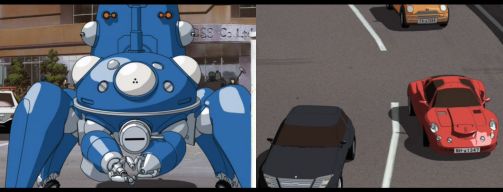
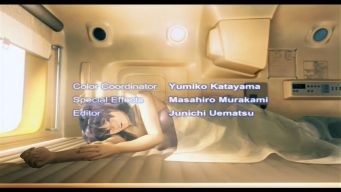
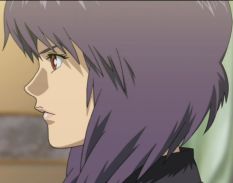
This is a good starting guide to what is an incredibly complicated property. My general rule of thumb is that everything is brilliant excelt for Man Machine Interface which I've read and re-read and still have no idea what's going on. I think the first series of Stand Alone Complex is the best incarnation of Ghost in the Shell, personally. ALthough I have to pick you up on this:
The concept of a "Stand Alone Complex" is defined in the series and followed up again in the second series, it doesn't just refer to the nature of the episodes. Please tell me they didn't take this out of the dubs because they've already butchered the translation enough.
By James H
October 25, 2006 @ 1:20 pm
reply / #
Yes, that bit is perhaps a bit inaccurate. I'm fairly certain that they did cover it in the subtitles, but I think I'd written that part of the article while still half-way through the series and obviously didn't pick up on it again once I'd finished.
By Jeffrey Lee
October 25, 2006 @ 2:14 pm
reply / #
I can't wait until I have time this weekend to sit and read this. I really enjoyed your other article and this looks to be equally worth reading.
By Philip J Reed, VSc
October 27, 2006 @ 2:33 am
reply / #
I remember the film being a major breakthrough (or it was at least touted as such by many critics) for anime...but I've never actually gotten the chance to see it. Regardless, it's always a pleasure to read a big, heavy article by someone who cares about their subject. I can't say I'm any more inspired to check out the film than I was, but I can say this was an hour or so of my time well spent.
By Philip J Reed, VSc
October 30, 2006 @ 12:33 am
reply / #
Excellent.
The first film is certainly very good, so if you enjoy sci-fi then it's worth giving it a shot. Some people say many of the ideas in The Matrix were stolen from GitS, so if you like that then chances are you'll like GitS. I don't really see many similarities myself, but that's another story.
Speaking of which, future articles from me are likely to be shorter, since this one probably is a bit too long (and obtuse) for most people :)
By Jeffrey Lee
October 30, 2006 @ 1:33 am
reply / #
>future articles from me are likely to be shorter
Bah! Humbug.
By Philip J Reed, VSc
October 30, 2006 @ 10:03 pm
reply / #
Well, I can write long ones if you really want...
By Jeffrey Lee
October 31, 2006 @ 12:34 am
reply / #
I'd say: just as long, but split into two parts, myself.
By John Hoare
October 31, 2006 @ 12:37 am
reply / #
The reason the cyborg hands are the way they are instead of using a physical connection is so that there's a physical airgap that allows them to work without having to worry about being hacked. If they were hooked up by usb (or something similar) then there is a very real possibility that someone could use that connection to get to them, whereas there's no way for that to happen if they simply type.
By Eric Johnson
June 05, 2007 @ 8:24 am
reply / #
ghost in the shell movies are technically the best animations i have seen for there respective times, and the same goes for the serries.
on the first movie the style seems to a little different from any other manga espesially in the case of the major, is because they are manga which is physically acurate while keeping manga propotions in a way. by that i mean the charactors could be build in true 3d form. the eyes are true spheres that sit inside the head, unlike traditional manga, the nose is closer to a human nose ect.
By del
July 31, 2007 @ 11:58 am
reply / #